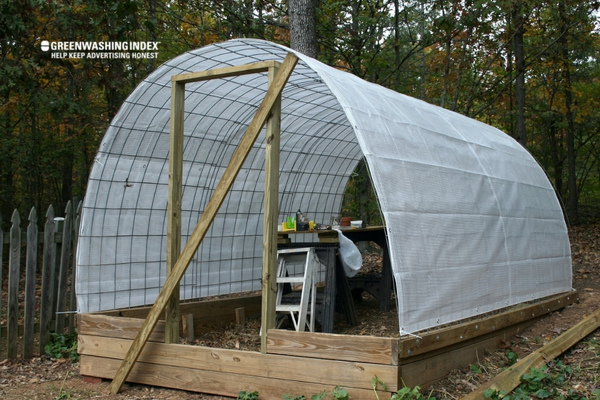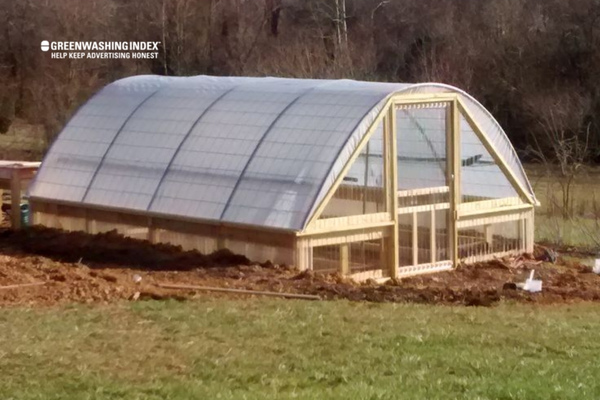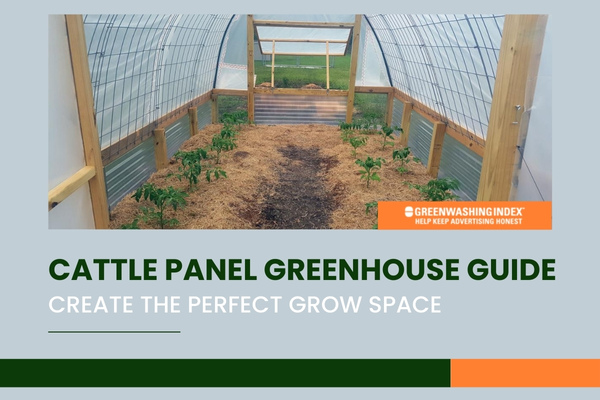Are you dreaming of a lush garden oasis that’s easy on the wallet? I’ll let you in on a little secret: the cattle panel greenhouse is where it’s at. Imagine walking into your own slice of a thriving, green haven, knowing you built it yourself! This isn’t just any gardening fad; it’s an affordable, durable solution that any green thumb can craft.
Building the perfect cattle panel greenhouse isn’t rocket science; in fact, I promise it’s easier than you think. Start with solid base frames—wood works wonders for a foundation—bend those sturdy cattle panels into beautiful arches for your structure, cover them with clear plastic sheeting to let in all that sunshine, and there you have it—a cozy home for your plants to thrive year-round. You don’t need expensive gear or professional help, just some basic tools and the willingness to get your hands dirty.
What You’ll Discover Here
- Step-by-step cattle panel greenhouse setup
- Affordable materials list for budget-friendly construction
- Top-notch design tips for maximum durability and style
- Essential upkeep advice for a lasting garden sanctuary
- Personal touches to make your greenhouse uniquely yours
Building Your Cattle Panel Greenhouse: An Introduction
When it comes to gardening, I have always looked for ways to extend the growing season. And that’s where a cattle panel greenhouse comes into play. It’s a smart and sturdy choice for folks who want to grow plants year-round without breaking the bank. Let me dive into why a cattle panel greenhouse might just be the perfect project for you.

Why Choose a Cattle Panel Greenhouse?
Now, you might wonder what makes a cattle panel greenhouse so special. Well, here are some of its benefits:
- Cost-effective: Cattle panels are much cheaper compared to other greenhouse structures.
- Durability: They’re made of strong steel that can stand up to wind and weather.
- Flexible design: You can make your greenhouse as big or as small as you need.
- Easy assembly: Building with cattle panels doesn’t require fancy tools or skills.
- Customization: It’s simple to modify and add features like shelves or extra supports.
So, whether you’re new to gardening or an old hand looking for an upgrade, consider this hearty structure. It could be just what your green thumb needs.
Key Features of an Ideal Cattle Panel Greenhouse
Now, before you grab your gloves and get going, let’s talk about key features. A top-notch cattle panel greenhouse should have the following:
- Sturdy Foundation: This is where everything starts. A solid base keeps your plants safe and secure.
- Quality Panels: The backbone of your structure – go for thick gauge steel that won’t rust away.
- Proper Covering: Choose a durable plastic sheeting that allows light in but keeps cold out.
- Ventilation: Plants need air, too! Make sure there’s a window or vent at each end.
- Accessibility: Plan doors wide enough so it’s easy to walk in with tools and plants.
Remember these points when planning; they will make all the difference in building a functional cattle panel greenhouse that lasts through seasons and brings joy with every sprout and bloom!
Selecting Materials for Your Cattle Panel Greenhouse
Building a cattle panel greenhouse is a fun and rewarding project that helps me extend the growing season of my garden. Let me guide you through choosing the right materials to ensure your DIY greenhouse stands up to the task.
Choosing the Right Cattle Panels
When I set out to select cattle panels for my greenhouse, I keep a few important factors in mind — durability, size, and price. Here’s how I go about it:
- Durability: Plants love stability, so my top priority is finding cattle panels that can withstand harsh weather. The panels should be made from sturdy wire with enough gauge (wire thickness) to hold up against wind and snow.
- Size: Next up, size matters because it determines how much space I’ll have inside my greenhouse. Typically, cattle panels come in lengths of 16 feet and heights ranging from 34 to 50 inches or more. I think about what is easy to bend and handle but also what fits nicely over the width of my garden beds.
- Price: Money doesn’t grow on trees – though we wish it did – so price plays into my decision, too. I look for a good balance between quality and cost-effectiveness. Usually, galvanized steel ones are a bit pricier but last longer.
Remember, picking stronger and appropriately sized cattle panels might cost more initially, but save money in repairs down the line.
Additional Materials Needed for the Project
Once I have my cattle panels decided upon, it’s time for me to gather other materials needed for this DIY project:
- Wood: Wood frames provide a solid base for attaching the cattle panels.
- 4×4 posts serve as sturdy corner supports.
- 2×4 planks make great framing elements that hold everything together.
- Plastic Sheeting or Greenhouse Film: To shield my beloved plants from bad weather while keeping them basking in sunlight, I cover the structure with plastic sheeting or specialized greenhouse film.
- Choose thick plastic with UV protection so it lasts longer without getting brittle or yellowed by sun exposure.
- Fasteners: Clearly vital since nothing sticks together by pure willpower!
- Fencing staples: These help fix cattle panels firmly onto wooden frames.
- Wood screws: Essential when building wooden structure parts.
- Additional items like zip ties can also be very helpful during construction to secure joints before permanently fixing them together with more durable fasteners.
With these materials picked out and prepped, you’re on your way toward creating your own little plant haven — a perfectly crafted cattle panel greenhouse!
Constructing Your Cattle Panel Greenhouse
Building a cattle panel greenhouse is a rewarding project for anyone who loves gardening. It gives you an all-year place to grow your plants. I want to guide you through making one, step by step.

Setting Up The Frame
To begin with the frame:
- Find the right spot: First, make sure you pick a flat area in your yard. It should get plenty of sunlight.
- Measure the space: You will need enough room for the length and width of your cattle panels, plus some extra space around them.
- Lay down heavy-duty ground anchors: These will hold your frame down so it doesn’t get blown away by wind.
- Set up base rails: These are long, straight pieces that make up the bottom edge on both sides of your greenhouse.
- Stand the cattle panels up one by one:
- Make sure they form an arch from one base rail to the other.
- Tie them together at the top where they bend to keep them secure.
Fitting The Panels
Now, let’s attach those panels:
- Use strong ties or wire: Always choose heavy-duty materials like these that can stand against harsh weather without breaking.
- Attach each panel end to the base rail securely:
- Start from one side and move to the other,
- Pull each panel tight against its neighbor,
- Fasten tightly, but take care not to bend or break anything.
Adding Doors and Vents
Doors and vents are very important:
- Decide where you want your door:
- Usually, on one end of the greenhouse is best,
- Make sure there’s enough room around it for easy access.
- Vents go on top:
- They let hot air out so plants don’t overheat,
- Place them along the highest point of your arch.
You’ve got yourself a sturdy greenhouse that can take on different weather. The placement ensures fresh air gets in while excess heat escapes – perfect for happy plants!
It’s important this info is clear so anyone can follow these steps. Safety comes first in construction; make sure everything is secured well. Enjoy planting in your new greenhouse!
Maintaining Your Cattle Panel Greenhouse
When you have a cattle panel greenhouse, keeping it in good shape is key to making sure your plants can grow all year round. Just like taking care of your car or your home, looking after your greenhouse needs some attention, too. Here’s how you can keep things running smoothly so your green thumb stays green.
Routine Upkeep Practices
Keep it Clean:
First things first, keep your greenhouse clean. This means sweeping out any leaves or dirt on the floor and wiping down surfaces to stop mold and pests from setting up shop. If you let these little critters move in, they might hurt your plants.
Check-Ups:
Just like going to the doctor for check-ups is necessary for staying healthy, giving your cattle panel greenhouse regular check-ups is just as important. Look closely at the panels and the frame of the greenhouse to make sure there’s no rust or weak spots.
Clear Plastic Coverings:
The plastic that covers the cattle panels keeps warmth in and cold out. Make sure this skin of your greenhouse has no tears or holes every once in a while – think of it as checking for cuts and scrapes on yourself.
Dealing With Damage
Sometimes, bad weather or plain old wear-and-tear can cause damage to your cattle panel greenhouse. Don’t worry; it’s usually not tough to fix!
For Broken Panels:
If a cattle panel does break, replacing it should be first on your list. A broken panel can mean less support for the whole structure and maybe even a chance for damage to spread.
Plastic Tears:
Now, when you find a tear in the plastic covering, patching it up right away will save you headaches later. You could use strong, clear tape made for greenhouses or go big with replacing whole sections if needed.
Fixing problems early keeps them from getting worse over time – think of protecting your garden, like taking care of a small scrape before it gets infected.
Taking these steps seriously makes having a DIY greenhouse more joyful than stressful – happy gardening!
Essential Tips & Tricks for the Perfect Cattle Panel Greenhouse
When I’m putting together a cattle panel greenhouse, I know the devil is in the details. To help you, here are some smart tips and tricks that will make sure you’re on the right path from the get-go.
Avoid Common Mistakes
First off, I cannot stress enough how important it is to avoid common mistakes during setup. Here’s what I have learned:
- Choose your site wisely: One big error people often make is not thinking about where their greenhouse will go. You need a spot that gets plenty of sunlight, ideally all day long. Make sure trees or tall buildings won’t shade your greenhouse.
- Get your dimensions right: Before you even buy your cattle panels, you should know exactly how big you want your greenhouse to be. Measure out your space, and keep in mind that each cattle panel generally spans 16 feet by 50 inches.
- Secure foundation: A lot of folks skip setting up a proper foundation because they think it’s not necessary for a DIY project like this one – but let me tell you, they’re dead wrong! A sturdy foundation keeps your structure stable against wind and weather changes.
- Connect panels securely: Some might just tie panels together with zip ties or wire without giving it much thought – bad idea! Use extra fencing staples or strong U-nails to firmly attach the cattle panels to wooden bases so nothing shifts around when things get windy.
- Plan for water drainage: Good drainage is key to keeping plants happy in your greenhouse. Make sure the ground slopes slightly away from where you set up so water doesn’t collect and become a problem later down the road.
- Use durable covering materials: Thin plastics might seem easier on the wallet now, but investing in UV-resistant polyethylene or polycarbonate sheets pays off as they’ll last longer under sun exposure and save replacement costs in future years.
By remembering these points, you dodge common blunders that can mess up a perfectly good cattle panel greenhouse before it even has a chance to shine!
Upgrade Ideas
Now let’s jazz up our basic structure with some upgrades that are more than just eye candy – they’re total game-changers for functionality:
- Internal Shelving:
- Adding shelves gives more room for plants and seed starts without eating into walking space.
- Use wood planks for natural-looking shelves.
- Metal brackets can hold heavier pots if needed.
- Automated Temperature Control:
- Install an automatic vent opener – this little gadget opens when it’s too hot inside and closes when temperatures cool down.
- Think about getting a thermostat-controlled heater, too, if you plan on keeping things growing during chilly seasons.
- Drip Irrigation:
- It can cut back on water waste by delivering slow drips right where plants need them most – at their roots!
- Kits are available at many garden stores; follow their instructions carefully so every plant gets its fair share of H2O.
- Insulation Upgrades:
- Bubble wrap stuck onto inner surfaces works surprisingly well as insulation without costing an arm and leg.
- Hanging mesh curtains (made with aluminum fabric) can reflect scorching summer sunlight away while trapping heat during colder times.
Each of these upgrades does wonders for making my cattle panel greenhouses more efficient and user-friendly over time – something every gardener loves!
Remember these essential pointers while building and upgrading: proper planning avoids common setup mistakes; layers boost cozy warmth; technological tweaks ease everyday tasks like watering & temperature adjustment; and finally, structured design elements maximize precious plant-growing space tucked inside. I promise following this approach always leads me toward creating an enviably functional haven brimming with thriving greenery under my very own cattle-panel crafted roof!
FAQs
What size are cattle panels?
Cattle panels usually come in sizes around 16 feet long and 50 inches wide. These dimensions can vary slightly by manufacturer.
What is required to build a greenhouse?
To build a greenhouse, you need a frame, which could be made of cattle panels, plastic or glass covering material, doors, vents for airflow, and sometimes a heating system, depending on your climate.
What makes a good greenhouse design?
A good greenhouse design maximizes sunlight exposure, has efficient ventilation to control temperature and humidity, and is sturdy enough to withstand weather conditions. It should also be sized appropriately for its intended use.
Conclusion
Building my own cattle panel greenhouse was not just a fulfilling DIY project but also a smart move for my gardening passion. This type of greenhouse offers an economical and robust solution for year-round plant growth. By carefully selecting the right materials, constructing the frame securely, and ensuring I’ve got all features like doors and vents in place, I’ve made sure that my greenhouse stands sturdy against all weather conditions. Regular maintenance keeps it in shape, ensuring that this simple structure provides a warm and inviting environment for my plants to thrive.
Key Takeaway Points:
- The cattle panel greenhouse is cost-effective and durable.
- Choosing quality materials guarantees longevity.
- Proper construction ensures stability.
- Regular upkeep is crucial for lasting use.
- Adding simple upgrades can enhance functionality.



